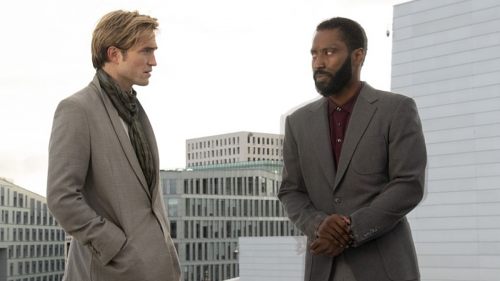INTERSTELLAR and 2001: A SPACE ODYSSEY – Echoes Through Time
Christopher Nolan hardly plays coy about his influences. He’s one of countless modern filmmakers who holds Stanley Kubrick in high regard, but what separates Nolan’s relationship to Kubrick’s work is the scale at which he’s able to replicate and incorporate it, taking what was once methodical exploration and bastardizing it beautifully; dumbed down, ramped up, and in service of searching for the emotional core that Kubrick was so often accused of lacking.
The first glimpse we get of this stylistic through-line is Inception’s hotel hallway, a complex practical effect borrowed from Kubrick’s steady introductions to Pan Am space flight and the Discovery One. The same principles apply: a camera remains fixed to a rotating set as actors move around it, creating the illusion of shifting gravity, or lack thereof. The specifics of how one builds, moves and lights such a stage could fill an entire novel, but it’s the relationship between the two finished products that provides the jumping off point. Where Kubrick’s is either melodious or mysterious depending on the chapter in question, Nolan’s is accelerated during a dream-heist, delivering heart-pounding excitement in the form of a well-dressed fistfight within the walls of a rattling subconscious. Hardly a dissectible connection beyond methodology, though one that forms the basis for the lens through which one might view Interstellar, Nolan’s most recent effort.
The labels of “cold” and “detached” have often fallen on both directors, lavish auteurs who like(d) their toys and their men-on-a-mission. These monikers are misappropriations to be sure, and the reasons why may as well unlock the relationship between Interstellar and 2001. Where Kubrick’s exploration is clinical, it was also intentional. An intellectual exploration of human evolution by stripping away humanity itself, whereas Nolan’s foray into time and space is a battle between emotional impulse and dutiful stoicism, not unlike his previous works. His exploration was of exploration itself, and the human desire to strive for it for a larger purpose.
The most obvious stylistic similarities come in the form of their spaceships, and how each director approaches their docking scenes. Kubrick’s rotating shuttle and space station mirror a harmonious waltz, while Nolan’s take center stage in the wake of an explosion, spinning to a dizzying degree. One is established as a matter of procedure, the other an action scene about overcoming the odds, and both are treated as extensions of human necessity. It’s almost a 1:1 parallel with the hallway rotation; watch the Kubrick scenes on fast-forward and you end up with something Nolan-esque, but this aesthetic robbery merely scratches the surface.
Birthdays are arbitrary in a cosmic sense, but they’re social and cultural markers for the passage of time. Kubrick presents two birthday scenes in 2001, one hovering just above the moon and the other further out by Jupiter, each through the layer of a video phone. The first involves Doctor Heywood Floyd telling his daughter that he’ll be missing her party, which isn’t even the primary reason for his call. The second involves astronaut Dr. Frank Poole being wished by his parents in a call that feels almost routine, his removal from the Earth and its people having made him more robotic than the vessel’s A.I. From the raw emotion of prehistoric Earth, to the formal demeanor of the Moon’s stratosphere, to the expressionless regimen of the far reaches of our solar system, 2001 sees us lose that which makes us human the further we are from one another.
Interstellar on the other hand, posits the very opposite. A cosmic force beyond our understanding of space and time keeps us connected – we call this love – and it permeates every scene and every decision from the moment Matthew McConaughey’s Cooper takes off. After he awakens from hibernation near Saturn, he views about a year’s worth of messages on a video screen. After the mission goes awry down on the water planet, he’s greeted by two decades worth of love and heartbreak, and finally, a gut-wrenching confrontation on his daughter’s thirty-third birthday. The passage of space and time is unkind to Nolan’s characters in a different way, and Cooper’s connection to those he left behind is almost stronger. Distance, heart, fonder, and all that.
If viewed as a continuum, this dueling detachment/attachment of the two works reaches its apex in their respective climaxes, as both Dave and Cooper are sucked into the unknown reaches of existence. Dave enters a construct where the idea of detachment takes on an almost literal connotation. As some unknown, unseen entities observe him, the passage of times comes about through shifts in perspective; out-of-body experiences where Dave sees or senses some version of his future, like time folding in on itself. In Cooper’s construct, time expands across an infinite horizon, but is focused on the very attachment that drives him and the day it was at its most strained. For Kubrick’s Dave Bowman, the future of the universe hinges on infinite knowledge. For Nolan’s Cooper, it hinges on a finite moment in his daughter’s bedroom.
Technology is the infinite unknown that takes Dave to wherever he ends up. A series of indefinable monoliths that represent… some kind of forward momentum for humankind. The vagaries of 2001 are woven into its text, and the monoliths have been a topic of debate amongst fans and scholars alike for damn near five decades. Even the controllable technology we create in the future, the artificial intelligence HAL, functions like a mystery. The question of his motives and emotional sincerity are something entirely unanswerable. Interstellar has no concern for the mysteries of technology and the replication of consciousness. The questions it asks even of science all come back to treating love as the ultimate conundrum, so much so that Nolan essentially combines the monolith and the A.I., making them one and the same (Granted, HAL already appears encased in a black rectangle, but Nolan literalizes the concept once more).
Nolan’s monoliths are TARS and CASE. They take us places just like Kubrick’s and process information that hold the keys to the universe, but they also make jokes and sarcastic quips. Regardless of whether or not their personalities are programmed, the “reality” of their emotional state is never called into question. Whether innate or externally hard-coded, Nolan’s take on emotion is that if it feels real, it’s real. This thesis is part and parcel of Inception too, where the imagined catharsis one experiences in a dream (or at the cinema) is just as real any in the real world.
It’s just as well then that the most widely accepted interpretation of 2001’s ending is focused on universal knowledge, with the “star child” returning to Earth and observing it like an omnipotent deity. In contrast, the result of Cooper’s construct is a father passing a very specific piece of knowledge on to his daughter through a personal memento, like leaving behind a piece of his soul. Where Kubrick’s aliens are a higher form of being, unattainable and formless, Nolan’s are human beings achieving their potential.
2001: A Space Odyssey takes aim at the head. Interstellar is focused on the heart.
This is by no means to pit the two against one another – they’re both operatic, overwhelming films that I’ve been lucky enough to experience in theatres five times each – if anything, they’re sides to a coin, using similar techniques and visual effects to tell radically different stories about our existence. Regardless of which one you might prefer, there’s value in these differing approaches. Nobody experiences art the same way, just as nobody creates it to say the exact same thing. Ultimately, while Kubrick’s film may have served as a warning for what we might lose and Nolan’s for what we might leave behind, they each find a radical exploratory solution to questions of our very existence. Knowledge and love, each driving us to explore. Each driving us to prepare to answer questions we may not have asked yet, but questions we may soon need answers to.



